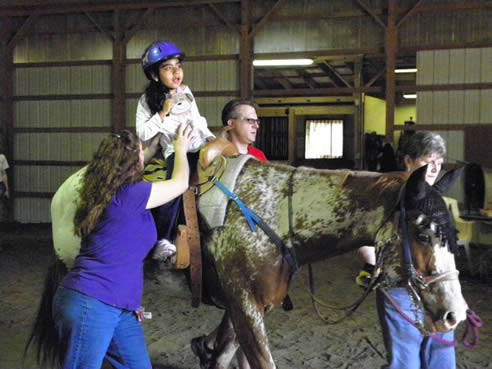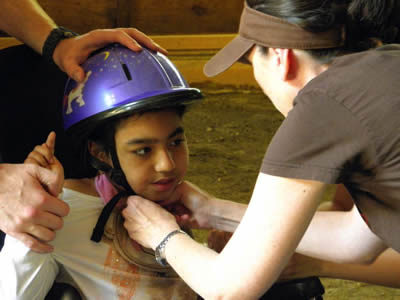
Horseytalk.net Special Interview
Starlight Farm
Small miracles are the stock and trade of this riding centre
 Tucked away on a gently sloping hillside just a stone's throw south of the Monksville Dam, there's a place where horses, therapy, and personal growth come together several times a week.
Tucked away on a gently sloping hillside just a stone's throw south of the Monksville Dam, there's a place where horses, therapy, and personal growth come together several times a week.
With every lap completed around the barn, students gain confidence in capable hands. A student from the Horizon School is fitted for a riding helmet by Starlight's speech and language therapist Meredith Bazaar.
Small miracles are the stock and trade of Rie Longo's Starlight Farm, where clients come out for therapeutic horseback riding and hippotherapy sessions that offer the benefits of occupational, physical, and speech therapies. Although traditional riding lessons and limited boarding are also available on site, Starlight's focus is on improving the lives of people with debilitating diseases and disabilities by offering them regular, supervised physical activity with horses. Most of the clientele are children, but people of all ages are welcome. As listed on Starlight's website, the conditions that can be improved through the use of therapeutic riding include cerebral palsy, autism spectrum disorders, ADHD, anxiety disorders, developmental delays, learning disabilities, Down's syndrome, and depression.
Longo has been at Starlight Farm since 1996. She founded her equine-based therapy program in 1999 as a way to bring together a lifelong love of horses with her training and background as a nurse. Starlight's staff consists of approximately a dozen paid workers, 10 or so therapy horses and between 12 and 20 enthusiastic volunteers, depending on the season of the year.
Crystal Oakley is a certified therapeutic riding instructor (CTRI) accredited by the Professional Association of Therapeutic Horsemanship International. She began her career as a volunteer at Starlight in her early teens, leaving only to attend Centenary College in Hackettstown.
"I went to school for this and came back," Oakley said. As Starlight's volunteer coordinator, she can't stress how important the gratuitous element is to their workforce.
"Without our volunteers," she said, "we wouldn't be able to run our program."
Kathy Viken, also a CTRI, is the volunteer recruiter at the farm. "We're always looking for new volunteers," she said. Some people come out to volunteer but only end up staying for a few months.
"Their lives change," Viken explained. "A lot of them don't know what they're getting into."
Those interested in becoming volunteers at Starlight Farms need no previous experience, Viken said. All training is provided. The qualifications are simple: You must be at least 14 years old and able to spend a few hours a week at the farm. The most important thing a volunteer will learn, Viken said, is how to keep the students secure atop their mounts.
 "You have to go by what the instructor or therapist tells you," she said.
"You have to go by what the instructor or therapist tells you," she said.
When Suburban Trends visited Starlight Farm on May 21, a group of nine students from Cerebral Palsy New Jersey's Horizon School in Livingston were scheduled for a 90-minute session. Longo explained that the nine students would be broken down into smaller sets and split their time into half-hour segments.
"We work with three at a time doing three separate activities," she said. The groups take turns working on an arts & crafts project, learning about the farm animals, and having an actual therapy session atop the horses. On that particular day, the students had hippotherapy with speech and language therapist Meredith Bazaar.
Longo explained a crucial difference between hippotherapy and therapeutic riding; hippotherapy is performed and supervised by a licensed therapist, while therapeutic riding is supervised by an instructor using basic skills of horseback riding to reach specific goals, such as increasing self-esteem or lower-body strength.
"People get confused between the two but there is a very definite line between them," Longo said.
In both disciplines, the movement of the horse gives riders input they're not getting on the ground. Because a horse's hips replicate the way in which humans walk, a non-walking rider gets a workout they may not otherwise have access to.
"Muscles have memories," Long said, "so that's what we're targeting."
In a speech therapy application, the movement of a walking horse strengthens the muscles of the diaphragm, which in turn helps improve language performance in the throat and mouth.
"We use the movement of the horse to get certain reactions from the students," Longo said.
Because many of Starlight's students have mobility issues, they are placed onto the horses from the platform of a long wheelchair-accessible ramp. This "crest mount" approach allows instructors, therapists and volunteers to ease the student onto the horse with greater control than if they began the process from the ground. Once the student is secured in the saddle, the therapy begins as the instructor/therapist leads the horse around the barn and volunteers spot the rider from every side.
Physical therapist Mark Liebert has been bringing students to Starlight from the Horizon School for several years. He says that visits to the farm are an integrated, ongoing part of the school's therapy program.
"It's not just pony rides or a field trip," Liebert said.
Time and again, Liebert has witnessed the positive effects of therapeutic horse riding and hippotherapy.
"Some of these kids are completely transformed just by getting on the horse," he said, adding that extraneous, nervous movements often disappear while the students are riding. Liebert said that it's not unusual to watch students straighten their posture during these sessions and speak more clearly than when they are not on a horse.
Believe it or not, Longo said, the horses have to stay in training, too. To keep them from becoming overworked, their participation is limited to four sessions a day, three days a week. Some of the horses are scheduled for regular riding lessons on other days. The goal is to prevent them from getting sore backs.
"We are constantly working with the horses to keep them happy and fit," Longo said.
She admits that running Starlight Farm is a delicate balancing act. The staff must exhibit a high level of sensitivity to the physical fragility of many of the clients, especially when they are interacting with animals that weigh half a ton or more.
"It works smoothly because everyone knows their job," she said. "Kirsten (Sharo, the barn manager) makes sure everything is fitting correctly, and then the instructors and therapists can concentrate on their specialty."
Without reservation, Longo recognizes the valuable contribution of the farm's unpaid contingent.
"We have great volunteers," she said. "They work very hard."
When it comes to working with new clients, Longo says, she and her staff assess how Starlight's programs can be of help. "We determine the goals and needs of the individual students, whether it is a recreational goal or a functional/medical goal."
For more information about Starlight Farm, or to volunteer with their equine-assisted therapy programs, call 973-728-6376 or log on to starlightfarms.org.
Interview sourced from www.northjersey.com/news
PHOTOS BY HOLLY STEWART




